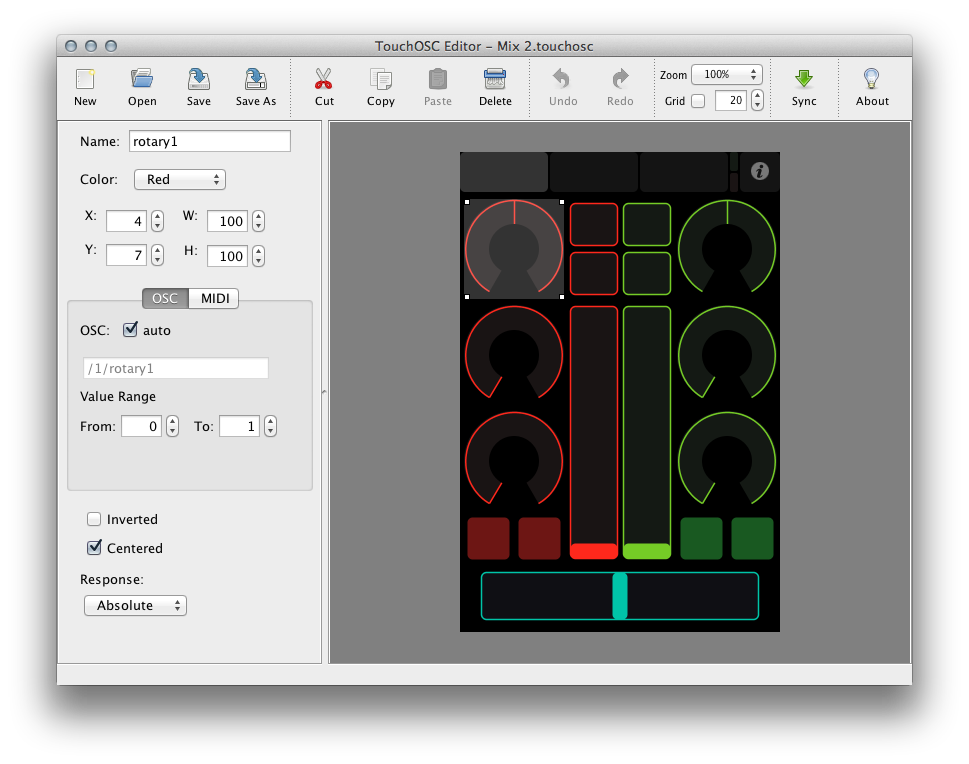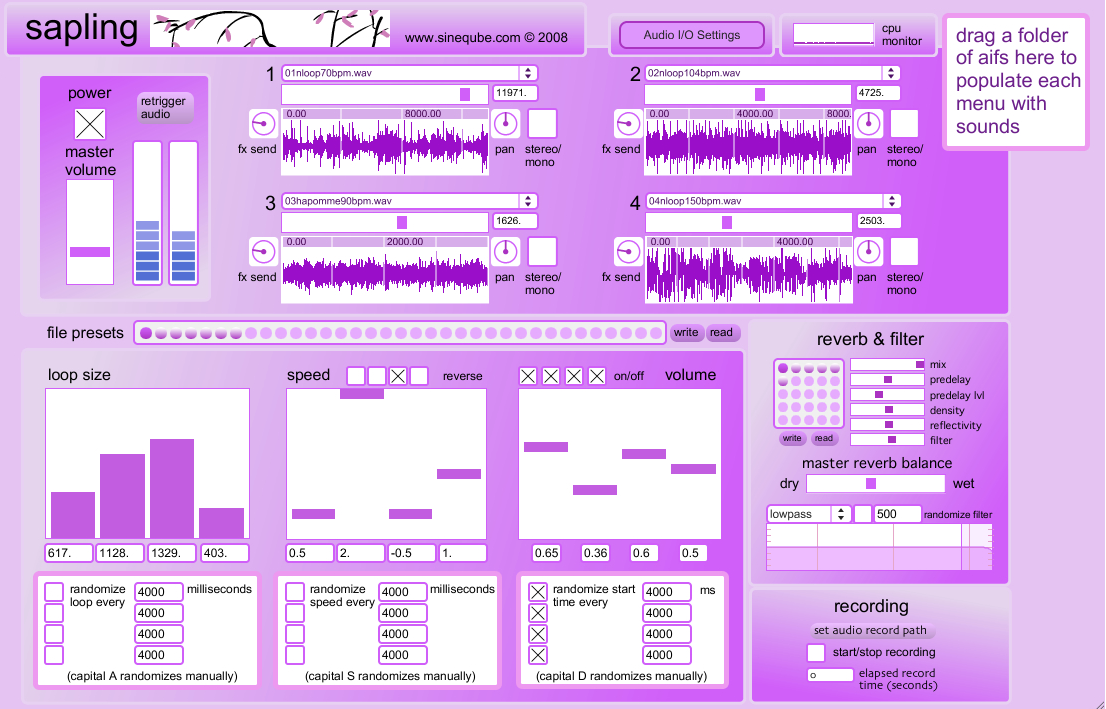Max is an infinitely flexible space to create your own interactive software
Connect Ideas Together to Create
OBJECTS
Each object does something. Max has objects that generate sound waves, represent hardware, or provide a UI for interaction.
PATCHCORDS
Patchcords connect one object to another. This connection lets objects share their output with connected objects.
CONTROL
Connect UI objects like dials and sliders to provide control values or display results. Modulate, map and scale data to get just the right results.
Max/MSP is not available for Linux but there are plenty of alternatives that runs on Linux with similar functionality. The most popular Linux alternative is Pure Data, which is both free and Open Source.If that doesn't suit you, our users have ranked 34 alternatives to Max/MSP and 18 are available for Linux so hopefully you can find a suitable replacement. By Cycling '74 Max was originally written by Miller Puckette as the Patcher editor for the Macintosh at IRCAM in the mid-1980s to give composers access to an authoring system.
Max Msp For Mac Os
Create Software Built Around You, In the Moment
Drag in your own audio clips and start manipulating them and connecting effects
Map your patcher with MIDI controllers as you go to start playing with your creation while you work
Max patching starts on a blank canvas, free of any structure. This makes it natural to build and explore unique ideas that would be too complex to make elsewhere. The Max patcher automatically expands to fit your work as it grows, no matter how much space you take up.
Explore Sound without Limits
Design a custom synthesizer with as many oscillators and effects as you wish.
Manipulate samples in every way, including timestretch and pitch shifting.
Build up more layered sounds using MC objects to patch multichannel audio.

Make Sound with a Gesture
In Max, you can build classic synths from scratch or get lost hacking together unusual sounds. Try the XY controls below to hear some sounds you could create with Max.

You can do a lot with just a single oscillator and a filter.
Add some extra modulation and try something a little more wild.
Make Visual Music
Max includes full-featured, expandable video and graphics tools with Jitter. Jitter is optimized for realtime audiovisual work, and is easy to combine with audio, sequencing, and modulation like everything else in Max.
Max provides the tools to connect your computer to the external world, or connect many computers together. With support for a constantly expanding list of hardware and communications, Max is ready to talk to everything.
Prototype and Evaluate
Flexible access to hardware makes Max a perfect environment for prototyping. Connect your development board to Max and get instant access to sensors, knobs, and switches. Watch the data stream in as you develop the interaction.
Countless commercial products, art installations, and stage shows have relied on Max to glue together all the parts of their process.
Generate Audio, Video, Code
Use Gen to patch together fine-tuned processes for audio, matrix data, or texture processing. Gen lets you combine procedural commands with visual patching to simplify the creation of custom processes.
Gen objects can also output source code to be used elsewhere if needed.
Extended Max
Max’s built-in Package Manager offers immediate access to over 50 add-ons covering everything from computer vision to support for hardware controllers including Novation, Monome and ROLI controllers.
If the feature you want doesn’t exist in Max, chances are someone in the community has created it. And if they haven’t, you can extend Max yourself using C++, NodeJS, Java, or JavaScript.
During your free trial period, Max is completely unlocked. That means you can open, edit, save, and create using all parts of Max without restriction. Just download Max and create an account to get started.
Get help when you need it
Max isn’t always easy. In fact, it’s often full of puzzles that are hard to solve alone. Visit our forums to seek out solutions and ask questions or join one of many Max courses and meetups worldwide.
If something isn’t working right or you are having trouble with installation, reach out to our support team.
| Developer(s) | Cycling '74 |
|---|---|
| Stable release | |
| Written in | C, C++ (on JUCE platform) |
| Operating system | Microsoft Windows, macOS |
| Type | Music and multimedia development |
| License | Proprietary |
| Website | cycling74.com/products/max/ |
| Cycling '74 Max 7 | |
| Paradigm | visual, flow-based, declarative, domain-specific |
|---|---|
| Developer | Cycling '74 |
| Stable release | |
| Website | cycling74.com/products/max/ |
Max, also known as Max/MSP/Jitter, is a visual programming language for music and multimedia developed and maintained by San Francisco-based software company Cycling '74. Over its more than thirty-year history, it has been used by composers, performers, software designers, researchers, and artists to create recordings, performances, and installations.[1]
The Max program is modular, with most routines existing as shared libraries. An application programming interface (API) allows third-party development of new routines (named external objects). Thus, Max has a large user base of programmers unaffiliated with Cycling '74 who enhance the software with commercial and non-commercial extensions to the program. Because of this extensible design, which simultaneously represents both the program's structure and its graphical user interface (GUI), Max has been described as the lingua franca for developing interactive music performance software.[2]
History[edit]
1980s:Miller Puckette began work on Max in 1985, at the Institut de Recherche et Coordination Acoustique/Musique (IRCAM) in Paris.[3][4] Originally called The Patcher, this first version provided composers with a graphical interface for creating interactive computer music scores on the Macintosh. At this point in its development Max couldn't perform its own real-time sound synthesis in software, but instead sent control messages to external hardware synthesizers and samplers using MIDI or a similar protocol.[5] Its earliest widely recognized use in composition was for Pluton, a 1988 piano and computer piece by Philippe Manoury; the software synchronized a computer to a piano and controlled a Sogitec 4X for audio processing.[6]
In 1989, IRCAM developed Max/FTS ('Faster Than Sound'), a version of Max ported to the IRCAM Signal Processing Workstation (ISPW) for the NeXT. Also known as 'Audio Max', it would prove a forerunner to Max's MSP audio extensions, adding the ability to do real-time synthesis using an internal hardware digital signal processor (DSP) board.[7][8] The same year, IRCAM licensed the software to Opcode Systems.[9]
1990s:Opcode launched a commercial version named Max in 1990, developed and extended by David Zicarelli. However, by 1997, Opcode was considering cancelling it. Instead, Zicarelli acquired the publishing rights and founded a new company, Cycling '74, to continue commercial development.[10][11][12] The timing was fortunate, as Opcode was acquired by Gibson Guitar in 1998 and ended operations in 1999.[13]
IRCAM's in-house Max development was also winding down; the last version produced there was jMax, a direct descendant of Max/FTS developed in 1998 for Silicon Graphics (SGI) and later for Linux systems. It used Java for its graphical interface and C for its real-time backend, and was eventually released as open-source software.
Meanwhile, Puckette had independently released a fully redesigned open-source composition tool named Pure Data (Pd) in 1996, which, despite some underlying engineering differences from the IRCAM versions, continued in the same tradition. Cycling '74's first Max release, in 1997, was derived partly from Puckette's work on Pure Data. Called Max/MSP ('Max Signal Processing', or the initials Miller Smith Puckette), it remains the most notable of Max's many extensions and incarnations: it made Max capable of manipulating real-time digital audio signals without dedicated DSP hardware. This meant that composers could now create their own complex synthesizers and effects processors using only a general-purpose computer like the Macintosh PowerBook G3.
In 1999, the Netochka Nezvanova collective released NATO.0+55+3d, a suite of externals that added extensive real-time video control to Max.
2000s:Though NATO.0+55+3d became increasingly popular among multimedia artists, its development stopped abruptly in 2001. SoftVNS, another set of extensions for visual processing in Max, was released in 2002 by Canadian media artist David Rokeby. Cycling '74 released their own set of video extensions, Jitter, alongside Max 4 in 2003, adding real-time video, OpenGL graphics, and matrix processing capabilities. Max 4 was also the first version to run on Windows. Max 5, released in 2008, redesigned the patching GUI for the first time in Max's commercial history.
2010s:In 2011, Max 6 added a new audio engine compatible with 64-bit operating systems, integration with Ableton Live sequencer software, and an extension called Gen, which can compile optimized Max patches for higher performance.[14] Max 7 was released in 2014 and focused on 3D rendering improvements.[15]
On June 6, 2017, Ableton announced its purchase of Cycling '74, with Max continuing to be published by Cycling '74 and David Zicarelli remaining with the company.[16]
On September 25, 2018 Max 8, the most recent major version of the software, was released.[17] Some of the new features include MC, a new way to work with multiple channels, JavaScript support with Node for Max, and Vizzie 2.[18]
Language[edit]
Max is named after composer Max Mathews, and can be considered a descendant of his MUSIC language, though its graphical nature disguises that fact. Like most MUSIC-N languages, Max distinguishes between two levels of time: that of an event scheduler, and that of the DSP (this corresponds to the distinction between k-rate and a-rate processes in Csound, and control rate vs. audio rate in SuperCollider).
The basic language of Max and its sibling programs is that of a. Hopes&Fears. Retrieved 2018-09-16.


|journal= (help)[permanent dead link][dead link]|journal= (help)|journal= (help)Max Msp For Mac Desktop
Max Msp Drum Machine
Msp Mac Jobs
External links[edit]
